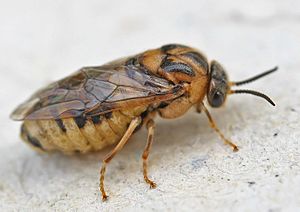Common pine sawfly
| Common pine sawfly | ||||||||||||
|---|---|---|---|---|---|---|---|---|---|---|---|---|

Common pine sawfly ( Diprion pini ), female |
||||||||||||
| Systematics | ||||||||||||
|
||||||||||||
| Scientific name | ||||||||||||
| Diprion pini | ||||||||||||
| ( Linnaeus , 1758) |
The common pine sawfly ( Diprion pini ) is a species from the family of the bushhorn sawfly (Diprionidae) within the hymenoptera .
The species is primarily known as a dangerous forest pest, as the larvae eat pine needles. It is known that they primarily feed on the Scots pine ( Pinus sylvestris ) but also on other types of pine such as the black pine ( Pinus nigra ).
Way of life
The male adults have very large and strongly feathered antennae, the "bush horns". This enables them to find the females that release a sex pheromone (Anderbrandt et al. 2005). The first activity is around May. Eggs are laid with the help of the ovipositor , which scratches the pine needle and thereby destroys a vascular bundle (Hilker et al. 2002). The female then closes the plant wound with a secretion from her kit gland. After hatching, the larvae initially eat fermented. Only the middle rib of the pine needle remains (brush damage). Older larvae eat individually, but are clustered. With large numbers of larvae, immense damage can be caused by feeding. The last larval stage migrates down the pine trunk, weaves into the leaf litter and pupates in the cocoon. These cocoons can overwinter (overlie) for several years. However, several generations per year are also possible.
When stressed (e.g. by predators) the larvae show a defensive position. You lift your head (nod) and release a drop of the foregut contents (regurgitation). This drop is terpenic and has a deterrent effect on enemies.
Natural enemies
Natural enemies are known for all stages of development. Egg parasitoids are for example Closterocerus ruforum or Dipriocampe diprioni . Known cocoon parasitoids are z. B. Drino inconspicua .
Possibility of decimation: insecticides in May immediately after the appearance of young larvae. For the allotment gardener: If you knock on the tips of the branches and jerk the branches, the larvae will fall to the ground. Possibly. repeat the procedure a few days later.
literature
- Wolfgang Schwenke (Hrsg.) Among others: The forest pests of Europe. Volume 4: Hymenoptera and Diptera . Parey, Hamburg 1982.
- O. Anderbrandt, G. Bergstrom, AB Wassgren, MA Auger-Rozenberg, C. Geri, E. Hedenstrom, HE Hogberg, A. Herz: Release of sex pheromone and its precursors in the pine sawfly Diprion pini (Hym., Diprionidae) . In: Chemoecology. 15, 2005, pp. 147-151.
- M. Hilker, C. Kobs, M. Varama, K. Cabinet: Insect egg deposition induces Pinus sylvestris to attract egg parasitoids. In: Journal of Experimental Biology. 205, 2002, pp. 455-461.
Web links
- Diprion pini at Fauna Europaea




